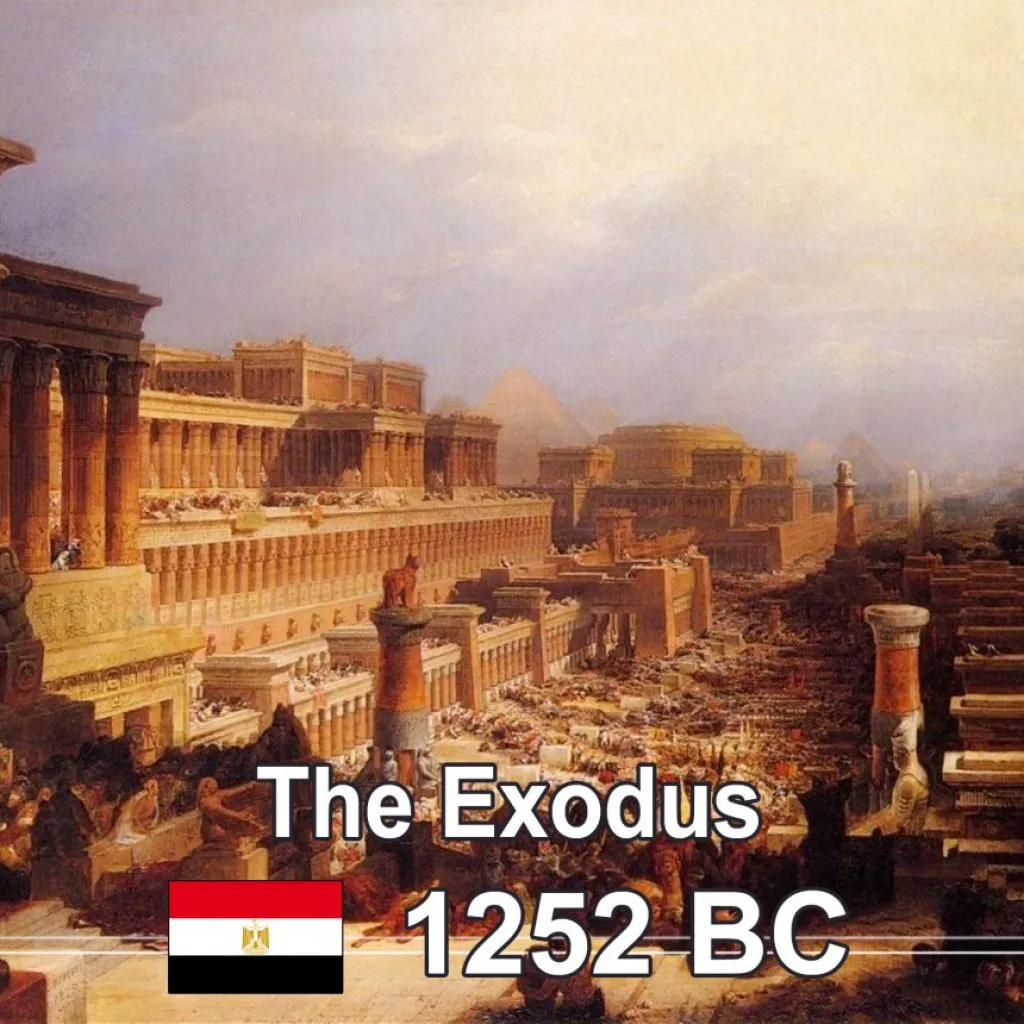
The Exodus
The Exodus is the founding myth of the Israelites. Spread over the books of Exodus, Leviticus, Numbers, and Deuteronomy, it tells of the enslavement that befell the children of Israel in Egypt, their liberation through the hand of Yahweh and the revelations at Sinai, and their wanderings in the wilderness up to borders of Canaan, the land their God has given them.
Its message is that Israel was delivered from slavery by Yahweh and therefore belongs to him through the Mosaic covenant, the terms of which are that Yahweh will protect his chosen people for all time, so long as they will keep his laws and worship only him.
The narrative and its laws remain central to Judaism, recounted daily in Jewish prayers and celebrated in festivals such as Passover, as well as serving as an inspiration and model for non-Jewish groups from early Protestants fleeing persecution in Europe to African-Americans striving for freedom and civil rights.
The traditions behind the Exodus story can be traced in the writings of the 8th-century BCE prophets, beyond which their history is obscured by centuries of transmission. No historical basis for the biblical Exodus story exists; instead, archaeology suggests a native Canaanite origin for ancient Israel.
NARRATIVE
The story of the Exodus is told in the books of Exodus, Leviticus, Numbers, and Deuteronomy, the last four of the five books of the Torah (also called the Pentateuch).
It begins with the Israelites in slavery. Their prophet Moses leads them out of Egypt and through the wilderness to Mount Sinai, where Yahweh reveals himself to his people and establishes the Mosaic covenant: they are to keep his torah (i.e. law, instruction), and in return he will give them the land of Canaan.
The Israelites accept the covenant and receive their laws, and, with Yahweh now present in their midst, journey on from Sinai, towards the promised land, but when told that the land is filled with giants they refuse to go on, and Yahweh condemns them to remain in the desert until the generation that left Egypt passes away.
After thirty-eight years at the oasis of Kadesh Barnea the next generation travel on to the borders of Canaan, where Moses addresses them for the final time, reviewing their travels and giving them further laws. The Exodus ends with the death of Moses on Mount Nebo and his burial by Yahweh, while the Israelites prepare for the conquest of the land.
COVENANT AND LAW
The climax of the Exodus is the covenant (binding legal agreement) between God and Israel mediated by Moses at Sinai: Yahweh will protect Israel as his chosen people for all time, and Israel will keep Yahweh's laws and worship only him.
The covenant is described in stages: at Exodus 24:3-8 the Israelites agree to abide by the "book of the covenant" that Moses has just read to them; shortly afterwards God writes the "words of the covenant" - the Ten Commandments - on stone tablets; and finally, as the people gather in Moab to cross into Canaan, the land God has promised them, Moses makes a new covenant between Yahweh and Israel "beside the covenant he made with them at Horeb" (Deuteronomy 29:1).
The laws are set out in a number of codes:
- Ethical Decalogue (i.e., the Ten Commandments), Exodus 20 and Deuteronomy 5;
- The Book of the Covenant, Exodus 20:22-23:3;
- Ritual Decalogue, Exodus 34;
- The ritual laws of Leviticus 1-6 and Numbers 1-10;
- The Holiness Code, Leviticus 17-26;
- Deuteronomic Code, Deuteronomy 12-26.
COMPOSITION
Scholars are broadly agreed that the publication of the Torah took place in the mid-Persian period (the 5th century BCE), echoing a traditional Jewish view which gives Ezra, the leader of the Jewish community on its return from Babylon, a pivotal role in its promulgation.
The tradition behind it stretches back some two hundred years before then, to a point in the late 7th century BCE when various oral and written elements were drawn together into works which were the fore-runners of the Torah we know today.
The first trace appears in the northern prophets Amos (possibly) and Hosea (certainly), both active in the 8th century BCE in the northern Israel, but their southern contemporaries Isaiah and Micah show no knowledge of an exodus.
The story may, therefore, have originated a few centuries earlier and there are signs that it took different forms in Israel, in the Transjordan region, and in the southern Kingdom of Judah before being unified in the Persian era.
SOURCES AND PARALLELS
While the Exodus story is no older than the Babylonian exile, there are indications that some historical memories underlie it: the name of Moses is Egyptian, for example, and many scholars have found it improbable that a humiliating tradition of slavery would simply be invented.
Egyptologist Jan Assmann suggests that it has no single origin, but rather combines numerous historical experiences into "a coherent story that is fictional as to its composition but historical as to some of its components" (Assmann, 2014). Thus the memory of Egyptian oppression may be based on the harsh treatment of Canaanites inside Canaan in the 2nd millennium, when the region was ruled by Egypt: these memories could later have been transferred to Egypt itself, and a new exodus story created.
A historical Moses associated with a small group may have been later generalised into the savior of Israel, while the history of the Hyksos, who were Canaanite rulers of the Egyptian Delta in the 16th century BCE, may have formed the basis of the descent into Egypt and the exodus.
GENRE
The meaning a reader takes away from a text depends on his or her understanding of the literary "type" to which it belongs: as one scholar puts it in his discussion of the Genesis creation myth, "it makes an enormous difference whether the first chapters of Genesis are read as scientific cosmology, creation myth, or historical saga" (Wood, 1990).
There is an almost universal consensus among scholars that the Exodus story is best understood as myth. More specifically, its can be understood as a "charter" (or foundation) myth, a myth told to explain a society's origins and to provide the ideological foundation for its culture and institutions.
HISTORICITY
The consensus of modern scholars is that the Bible does not give an accurate account of the origins of Israel. There is no indication that the Israelites ever lived in Ancient Egypt, and the Sinai Peninsula shows almost no sign of any occupation for the entire 2nd millennium BCE (even Kadesh-Barnea, where the Israelites are said to have spent 38 years, was uninhabited prior to the establishment of the Israelite monarchy).
In contrast to the absence of evidence for the Egyptian captivity and wilderness wanderings, there are ample signs of Israel's evolution within Canaan from native Canaanite roots.
While a few scholars discuss the historicity, or at least plausibility, of the Exodus story, the majority of archaeologists have abandoned it, in the phrase used by archaeologist William Dever, as "a fruitless pursuit".
The biblical exodus narrative contains some details which are authentically Egyptian, but such details are scant, and the story frequently does not reflect Egypt of the Late Bronze Age or even Egypt at all (it is unlikely, for example, that a mother would place a baby in the reeds of the Nile, where it would be in danger from crocodiles). Such elements of the narrative as can be fitted into the 2nd millennium could equally belong to the 1st, consistent with a 1st millennium BCE writer trying to set an old story in Egypt. (The name of Moses, for example, belongs to 1st millennium Egyptian, and would have been Mase in the 2nd). As a result, while a few scholars continue to discuss the historicity, or at least plausibility, of an exodus as described in the Bible, most histories of Israel do not include the Egyptian captivity, the Exodus, or the wilderness wanderings in their discussion of Israel's origins.
A century of research by archaeologists and Egyptologists has found no evidence which can be directly related to the Exodus captivity and the escape and travels through the wilderness.
Archaeologists generally agree that the Israelites had Canaanite origins: the culture of the earliest Israelite settlements is Canaanite, their cult-objects are those of the Canaanite god El, the pottery remains are in the Canaanite tradition, and the alphabet used is early Canaanite.
Almost the sole marker distinguishing the "Israelite" villages from Canaanite sites is an absence of pig bones, although whether even this is an ethnic marker or is due to other factors remains a matter of dispute.
According to Exodus 12:37-38, the Israelites numbered "about six hundred thousand men on foot, besides women and children", plus many non-Israelites and livestock. Numbers 1:46 gives a more precise total of 603,550 men aged 20 and up. It is difficult to reconcile the idea of 600,000 Israelite fighting men with the information that the Israelites were afraid of the Philistines and Egyptians.
The 600,000, plus wives, children, the elderly, and the "mixed multitude" of non-Israelites would have numbered some two million people. Marching ten abreast, and without accounting for livestock, they would have formed a column 240 km long.
The entire Egyptian population in 1250 BCE is estimated to have been around three to 3.5 million and no evidence has been found that Egypt ever suffered the demographic and economic catastrophe such a loss of population would represent, nor that the Sinai desert ever hosted (or could have hosted) these millions of people and their herds.
Details point to a 1st millennium date for the composition of the narrative: Ezion-Geber (one of the Stations of the Exodus), for example, dates to a period between the 8th and 6th centuries BCE with possible further occupation into the 4th century BCE and those place-names on the Exodus route which have been identified - Goshen, Pithom, Succoth, Ramesses and Kadesh Barnea - point to the geography of the 1st millennium rather than the 2nd.
Similarly, Pharaoh's fear that the Israelites might ally themselves with foreign invaders seems unlikely in the context of the late 2nd millennium, when Canaan was part of an Egyptian empire and Egypt faced no enemies in that direction, but does make sense in a 1st millennium context, when Egypt was considerably weaker and faced invasion first from the Achaemenid Empire and later from the Seleucid Empire.
The mention of the dromedary in Exodus 9:3 also suggests a later date - the widespread domestication of the camel as a herd animal is thought not to have taken place before the late 2nd millennium, after the Israelites had already emerged in Canaan and they did not become widespread in Egypt until c. 200-100 BCE.
There have been as yet undated ruins discovered at Khirbet el Mastarah near the Jordan river that could offer evidence of an Iron Age nomadic people migrating into ancient Canaan.
David Ben-Shlomo, an archaeologist with Ariel University, has stated that "We have not proved that these camps are from the period of the early Israelites, but it is possible."
HOW LONG WERE THE ISRAELITES IN EGYPT?
1174 BC - EXODUS?
















































